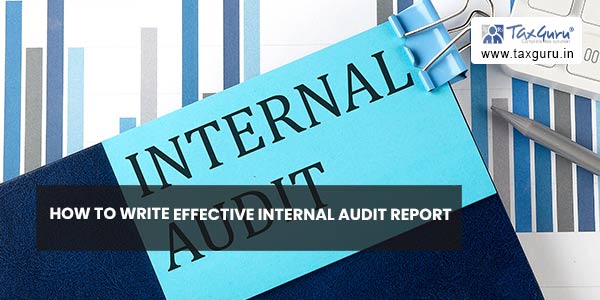Reporting must ensure (Concept of Reporting) : Reporting is the final outcome of any audit exercise, improper reporting can make whole audit exercise futile. While drafting we must keep in mind that – Firstly, Audit report is the outcome of audit which report user (Management, Senior Executives and Audit Committee) will see so it should be as per their requirement, Secondly, Report must explain context of Audit and testing efforts undertaken by the auditors, Thirdly, Audit report must be simple i.e. it is clear and easily understandable, Fourthly, Report is written in a logical manner (i.e. Scope and content of report is logically addressed), Fifthly, On reading of report it must be understandable to a person who is not part of audit process undertaken and Lastly, Executive summary is written in such a manner that it is stand – alone.
Further to ensure its effectiveness auditor should check how much Audit Recommendations previous reports are implemented, How many findings are repeated in report, Your report focus future rather than past, Audit opinion, finding, conclusions and recommendations really represent the key issues and finally that all Recommendations are practical.
We must always pay attention to the objective of Internal Audit which is to provide opinion on the control systems (risk management arrangements) in respect of the areas reviewed and to make recommendations for improvements, where appropriate.
Before Writing a report we must take time, understand scope and objective, make notes to clarify ideas and assemble facts & findings and identify recommendations.
Order of Report Writing (Procedure of Reporting) : To make and Internal Audit report useful it should be written in such a way that it is divided in following parts :-
- Main Body of report which contains Statement of facts and findings. This part may further contain sub parts like :-
- Brief description of Auditee in first few pages
- Comprehensive Index in next few with brief remarks
- Logically sequenced paragraphs on areas under review – this sub part may have back ground, methods employed and results
- Conclusions and recommendations: conclusions and opinions on areas under review and recommendations to improve them are to be made part of this section.
- Introduction of something (Concept or Mechanism) which has been made part of main body
- Appendices : Auditor need to put together a glossary, reference, bibliography etc to support facts and findings in the main body.
Guiding Lamp Posts (Principles): All audit reports needs to be customized. The report highlights a problem and recommends action which should be taken to change things.
- Simplicity : report should be short and must have unadorned sentences and meaningful paragraphs. Exaggerated prose, overuse of adjectives and flamboyancy should be avoided.
All parts of report must make sense, repetition must be avoided as far as possible, caveat to recommendations must be avoided, emotive language must be avoided.
- House Style : It must be ensured that whole of the report is written in a consistent house style. If we are using passive voice then whole of the report must be in passive voice, on the other hand if active voice is used we should use it in whole of the report.
- Presentation : Report must not have presentation problems. We must check that Headings are appropriate, logical and serially numbered. Report must reflect the work undertaken by the auditor, report must be free from errors related with spellings, grammar and punctuations. Name of auditors must also be on report.
- Review : Report must be reviewed considering – a. Suitability of report for users, b. Title are consistent with scope, c. Summary/Index cover main points, d. all component parts are given appropriate weight, e. all necessary paragraphs are incorporated and unnecessary paragraphs are eliminated and f. possibility to add value in layout.
- Content : Firstly, The content Audit report must have a. Observation of Auditor (Duly supported by sufficient evidence as far as possible in terms of quantitative data). Secondly, Audit report should contain clearly spelt implications of the observation of the auditor and Finally, Recommendations of the auditor must find place in audit report. Auditee’s comments may also be made part of audit report.
Various Assurance Levels : Various areas of audit report may have different level of assurance. There can be four level of assurance(Can be well understood by examples):
- Substantial : A sound system of control which should provide management with assurance that risk are being appropriately managed is in existence for store.
- Adequate: A generally sound system of control but with a few identified weaknesses (shown as annexure) which could, if not rectified, put controls system at risk.
- Limited: Significant weakness have been identified (shown as annexure) which would, if not rectified promptly, place control system of stores at serious risk.
- No- A system of control and risk management is not present for stores
Rule of Grammar to be observed : There are some grammatical rules which are often violated at the time of writing of report :
Apostrophes Rule: An “s” with an apostrophe immediately after it shows that there is more than one owner (word is plural).
- Small companies’
- Creditors’ meeting
Apostrophes are not used for non possessive plurals : 1980s, MPs etc.
Subject/Verb agreements Rules:
- Singular subject must have a singular verb and plural subject shall have a plural verb
- Two or more singular subjects are joined by and use a plural verb. If two or more singular subject ae joined by or or nor use singular verb
- Use singular verb after everyone, everybody, nobody, someone, every, one, another and much
- Use plural verb after both, few, many, others and several
- If the group is acting as one unit use a singular verb

Use of Capital Alphabets Rules:
- Capital Alphabets are used for particular and lower case are general example this year’s Budget was a boring budget.
- Capital Alphabets are used for days, months, holidays but not for seasons
- Capital Alphabets are used for First, last and principal words of books, plays and programmes e.g. My experiences with Truth
- Use Capital Alphabets for periods, trade names, countries, continents, streets, roads, motorways and other public places, academic qualifications and academic and religious titles
Numbers: Figures or words Rules:
- Numbers from one to ten are expressed as words (Two, Four)
- Numbers from 11 onwards are expressed as figures (32,75,564)
- Use number for Dates and Times (3 September 9.30 am), dimension and weights, numbers following noun (page3, chapter8)
- Use word for Exact amounts when they begin a sentence – Thirty companies
- Approximate amount and fractions – about a thousand attended
The Fog Factor: The fog index refers to a readability test that aims to determine the level of text difficulty, or how easy a text is to read. The index provides a reader with the number of years of education that he or she hypothetically needs to understand and digest a particular text on the first reading.
How to Calculate the Fog Index
To calculate a fog index score, we need to know the three following components:
1. Average sentence length
2. Percentage of long words present in the text
3. Sum of the average sentence length and the percentage of long words
To calculate the average sentence length, we need to divide the number of words by the number of sentences in a text sample. To find the percentage of long words, we divide the number of long words by the total number of words and multiply the result by 100. A long word is defined as a word with at least three syllables.
Finally, the sum between the average sentence length and the percentage of long words is computed to arrive at the fog index. There are a few exceptions to what is defined as a long word. Here is a list of the exceptions for long words:
- Words starting with a capital letter such as company names
- Combined “short-words” such as “share-holders” or “over-draft”
- Words with three syllables just because we added “ed” or “es” (e.g., created or practices)
- Short three-syllable words, such as “media”
Ideal Fog Index Level
For business writing, we aim for a fog index of between 20 to 25. For longer and more technical text scripts, such as official reports, we aim for 30 to 35. Anything more than these suggested figures is getting too complex to be understood by the average reader. The easier it is for the reader to understand what you are saying, the more likely they will want to read your message.





